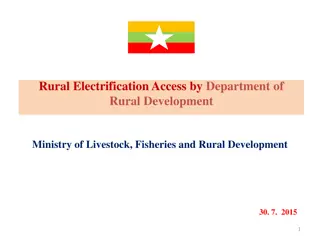Understanding Rural Marketing: Opportunities and Challenges
Rural marketing involves reaching out to people in rural areas to convert their purchasing power into effective demand for goods and services. It presents unique opportunities due to the large and scattered population, but also challenges like low standard of living and limited market exposure. Marketers need to tailor their strategies to suit the diverse and traditional consumption habits of rural consumers.
Download Presentation

Please find below an Image/Link to download the presentation.
The content on the website is provided AS IS for your information and personal use only. It may not be sold, licensed, or shared on other websites without obtaining consent from the author. Download presentation by click this link. If you encounter any issues during the download, it is possible that the publisher has removed the file from their server.
E N D
Presentation Transcript
Emerging Emerging Trends in Marketing Trends in Marketing
Rural Marketing: Rural Marketing: Rural marketing refers to the activities undertaken by the marketers to encourage people living in rural areas, to convert their purchasing power into an effective demand for the goods and services and making this available in the rural areas, with the intention to improve their standard of living and achieving the company s objective.
Features: Large and scattered population: More than 70% of India s population lives in rural areas. The rate of increase in rural population is also greater than that of urban population. The rural population is scattered in over lakhs of villages. Nearly, three-fourth (3/4 th) of the country s consumers are in rural markets. Higher purchasing capacity : Purchasing power of the rural people is on a rise. Marketers have realized the potential of rural markets and are expanding their operations in rural India. Heterogeneous: The rural market in India is not only scattered, but is also diverse and heterogeneous. Rural consumers are diverse in terms of religion, social, culture and in language factors.
Low standard of living : The standard of living of rural areas is low and rural consumers have diverse socio-economic backwardness. A consumer in a village area has a low standard of living because of low literacy, low per Capita income and low savings. Development of Infrastructure : There is development of infrastructure facilities such as construction of roads and transportation, communication network, rural electrification and public service projects in rural India, which has increased the scope of rural marketing. Low exposure : There is also exposure to market in rural areas. Low product exposure, low exposure to branded products, limited sources of information, less retail outlets, low market reach etc create a big challenge to marketers to stimulate the rural consumers.
Buying in less quantity: Generally, rural consumers buy loose i.e in small quantities on account of their low percapita income and limited storing capacity. Traditional bound: Rural consumers are tradition bound, region, culture and tradition influences their consumption habits. They do not prefer changes. Marketing Mix: The urban products cannot be dumped on rural population. Separate set of products need to be designed for rural consumers to suit the rural demands. The marketing mix elements are to be adjusted according to the requirements of the rural consumers. Seasonal and irregular: The rural market in India is seasonal and irregular. The predominance of agriculture in the income pattern of the rural people and the relatively greater influence of marriages and festivals on the purchase pattern of the villagers are the main reasons for seasonal character of the rural market.
Causes for the changes in the volume and patterns of rural consumption: Rural communication : Internet and mobile have played the most important role for the growth of rural markets. Broad band services are easily available in rural area. These facilities have opened the doors for companies to use latest technologies for brand promotion. Socio economic charges : The change in lifestyle and economic status is one of the most important factors that have driven the rural sector towards improvement. The source of information and awareness of the rural people have changed their habits, tastes and preferences. Literacy level : This is the major factor for the improvements of rural sector i.e. increase in literacy level of the rural people. There is huge improvement in the sources of information and education.
Increase in expectations: With the media reach and high income level, the awareness and preference of the rural people have been developed. Their demand towards quality products with better pricing has increased. Instead of being price conscious the rural people are also expecting good quality products and are aware of branded products. Increase in income : The growth in rural markets has reduced the complexity of its functions. With the increase in income level of rural people, their purchasing power and economic status of living have also developed. Infrastructure facilities: Infrastructure and communication play a vital role in bringing the improvement of rural sector. Well developed roads, hi-tech media and electricity lead to improvement of the entire marketing activities.
Raising rural prosperity : The agricultural development programs of the govt. have helped to increase income in the agricultural sector. This has created greater purchasing power in rural markets. Rural markets are developing not only from agricultural section but also from other sections. Change in rural consumer behavior : With the economic development of rural areas, disposable income of rural people has gone up. Because of internet and TV, people have started gaining knowledge about the different trends that are available in urban markets. They have started realizing the importance of branded products. Favourable Government Policies : The government is being making efforts towards rural development. The massive investment in the rural India has generated new employment, new income and new purchasing power. Various measures like tax exemption in rural areas, subsidy, concessions, incentives, literacy assistance etc has brought in rapid development in rural markets. Remittance from family members working in urban areas : At least one of the family members from almost every rural family works in cities they remit their salaries lack home to their family. This has contributed to growing rural income and purchasing power of rural people. Also rural people are in growing interaction with urban communities.























